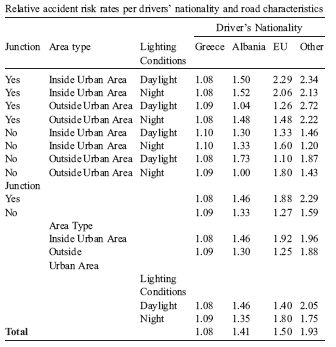
This paper reports on the accident risk of foreign and native drivers in various road environments in Greece. In particular, the analysis aims to determine the combined effect of driver nationality, area type (inside/outside urban area), junction (yes/no), and lighting conditions (day/night) on accident fault risk. Methods: Data from the national accident database of Greece are used in a hierarchical log-linear analysis. The induced exposure technique is applied due to the lack of exposure data. Estimated and observed odds ratios are then examined for the quantification of the various effects in terms of relative risk. Results: The initial examination of a saturated model leads to the rejection of all three- and higher-order effects within variables, without providing an adequate fit to the data. On the contrary, a non-saturated second order model presents a very satisfactory overall fit. The examination of single and combined effects indicates that the most significant effect on accident risk rises from the presence of foreign drivers at junctions. Conclusions: Results confirm that foreign drivers in Greece are at increased risk. However, immigrant permanent residents appear to have a lower risk compared to tourists, regardless of the road environment.
| ID | pj23 |
| Manuscript | |
| DOI | |
| Tags | accident analysis, driver behaviour |






